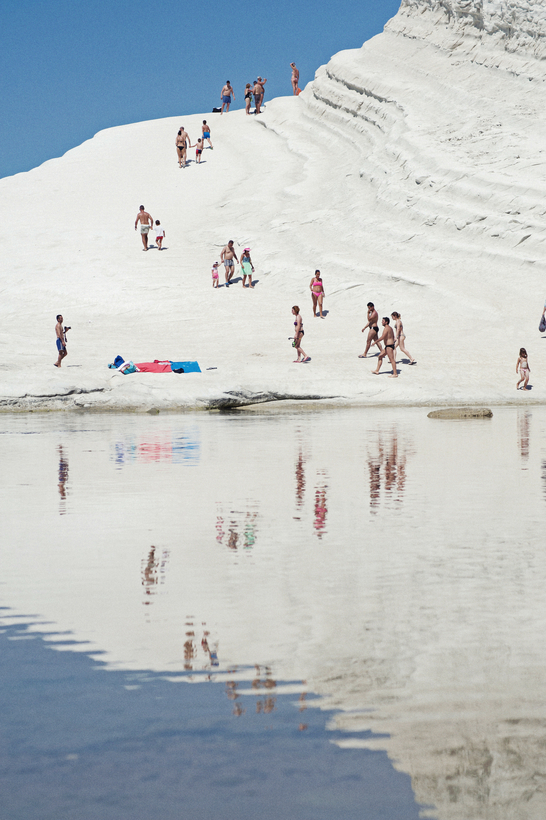Americans likely associate Sicily, the island off the tip of Italy’s boot, with two things: Al Pacino’s wedding scene in The Godfather, and boatloads of refugees stumbling off rickety boats onto its beaches.
Jamie Mackay’s book fills in the lines with a history of Sicily as lush and vibrant as the mountainous little dot where ancient Greeks, Africans, Arabs, and Northern Europeans have clashed, coexisted, and interbred over millennia, leaving behind a land and people that are the essence of Mediterranean.

“All the early myths about Sicily are concerned with refugees,” Mackay writes, beginning with Arethusa, a nymph who fled to the island from Arcadia to escape the unwanted harassment of the river god Alpheios. Artemis, goddess of hunting, turned Arethusa into a nondescript stream in southern Sicily, but Alpheios found and raped her anyway.
Sicily was colonized and re-colonized many times throughout history. First to arrive were the ancient Greeks, who built Syracuse, a city as culturally important as Alexandria and Ephesus, in 734 B.C. Plato visited the island and was baffled by its politics, especially the tyrannical rule of the “unvirtuous coward” Dionysius I. Archimedes, meanwhile, refined his theories on density in Sicily.
A mountainous little dot where ancient Greeks, Africans, Arabs, and Northern Europeans have clashed and coexisted over millennia.
Like Greece, North Africa is a primeval part of Sicily’s story, too. The original Sicanian inhabitants and early Phoenician population on the island’s west coast had trading posts just across the sea from Tunisia, and worshipped Astarte, an African goddess of war. A shrine to her at Erice later morphed into temples to Aphrodite and then the Christian Madonna. “The fact that her temple existed at all,” Mackay writes, “is an important and often overlooked indicator of how African traditions helped feed Sicily’s mythological imagination.”
By the sixth century A.D., Byzantine Sicily was Christian but multicultural, with such a vibrant Jewish-diaspora culture that it remains today home to the oldest functioning mikvah (ritual bath) in the world.

The Byzantine era ended with the Islamic conquest beginning in the ninth century. The Aghlabids of Ifriqiya (now Morocco and Tunisia) destroyed Syracuse but moved the capital to Palermo, a city more like Cairo than Florence in design, with a long main road instead of a central piazza. The Islamic rulers educated much of the population, including the peasantry, and its upper classes left behind a taste for Arab flavors—date biscuits, marzipan, nougat, and lemon granita then concocted with snow collected from nearby Mount Etna—before being expelled by Norman invaders from Northern Europe.
An idyllic 50 years of Norman rule ended with the advent of the Black Plague, which wiped out 70 percent of the islanders, and reduced the peasantry to centuries of brutal, racist control by Spain and the papacy. Inquisitors crushed diversity of thought and harassed and expelled Jews. By 1500, Judaism in Sicily had died.
The Islamic rulers left behind a taste for Arab flavors—date biscuits, marzipan, nougat, and lemon granita then concocted with snow collected from nearby Mount Etna.
The Sicilian language today contains fragments of these waves of inhabitation and control, with words rooted in Greek, French, and Arabic. Sicilians were sharing stories of King Arthur as early as the 11th century, Mackay writes, alongside folk tales from Egypt and Morocco and German fairy tales with goblins and dwarves.
In Mackay’s telling, the history of Sicily is an experiment in whether the human species can find, if not commit to, tolerance between nations and races. It has always been “a polarized place,” he writes, “characterized by extreme contrasts of bounty and scarcity, pleasure and pain, beauty and ugliness …”

The Cosa Nostra—the Sicilian Mafia—emerged as a political force after the island became part of a united Italy in the mid-19th century. One hundred fifty-two criminal gangs ran the island for years after that, and to some extent still do, although their power waned after the audacious murders of two anti-Mafia prosecutors in the 1990s brought a crackdown on organized crime in Italy and the arrest of the true Godfather, Toto Riina. (Mackay suggests the American army might have given the Mafia an inadvertent boost by releasing hundreds of criminals from Sicily’s jails when liberating the island from fascism in 1943.)
Concluding this sweeping narrative is an upbeat epilogue set in 2020s Palermo. Today, the city is teeming with new arrivals. The Ballarò neighborhood was designed as a souk by the Muslim Arab Aghlabids, and, a millennium on, it is again a Mediterranean stew of languages and cultures that, for the moment, looks like a beacon of coexistence.
“If Ballarò is anything to go by, Sicily’s future might indeed be more tolerant and more ethnically diverse than any time in its recent past,” Mackay writes. “Whether this will be sustainable in the long term, of course, will depend on whether more powerful political actors can step in to defend the experience from the threat of criminal violence, which unfortunately remains a serious problem.”
Nina Burleigh is a journalist and author. Her most recent book, Virus: Vaccinations, the CDC, and the Hijacking of America’s Response to the Pandemic, is out now


